
http://www.glasstone.blogspot.com
Double flash of nuclear explosions
There is a characteristic double flash emitted by nuclear explosions. The explosion is bright, then becomes dull and then becomes bright again. If seen this is a signature of a nuclear explosion. This double flash can be seen from space. The larger the explosion the clearer this phenomenon can be seen.

Note the scale is logarithmic on both axes Mr Reid: Nuclear Double Flash . Graph taken from Guy E. Barasch, “Light Flash Produced by an Atmospheric Nuclear Explosion”, LASL-79-84, Los Alamos National Laboratory, 1979.

Castle Bravo nuclear test. The flash is bright at first, grows duller, and then becomes bright again, producing the classic double flash of nuclear explosions. Mr Reid: Nuclear Double Flash
North Tower nuclear flash
The nuclear flash of the North Tower detonation. The double flash is very hard to see in this GIF because the yield of this nuclear explosion is relatively low.

From CNN video of the North Tower

Fireball of Trinity nuclear test
Explanation of the double flash of nuclear explosions
At the beginning of the explosion, as the elements of the bomb heat up to 10 million kelvin, UV and xrays are emitted. These heat the air to around 1 million kelvin, which causes the emission of light. This is the first very fast peak of light – the first flash.
While this is going on, the shock wave from the explosion is spreading outwards and it compresses the air in front of it. The air is superheated and turns into a plasma that is opaque to light. So the light dims.
As the shock wave expands, it cools rapidly and as it does so it becomes more transparent, allowing the light trapped behind it to escape. This is the second peak of light seen in nuclear explosions
Adapted from Mr Reid: Nuclear Double Flash
Graph showing the time gap between the two flashes
The time of the minimum light flash and the time of the second maximum flash depend on the weapon’s yield. A larger yield will produce a greater gap between the two flashes.
For a one kiloton device, the time between the minimum and the second maximum is only 30 milliseconds, too short a gap for the human eye to perceive. For larger weapons, such as a 100 kT warhead, the interval is long enough (0.3 seconds) for human beings to perceive.
Adapted from Mr Reid: Nuclear Double Flash

Graph of the two flashes. Note the logarithmic scale. The bigger the yield of the bomb, the bigger the interval. (Adapted from Mr Reid: Nuclear Double Flash)
The shadows left behind

http://www.icpj.net/dwg/shadow.htm Interface Council for Peace and Justice

The heat of the blast, estimated at 3000 to 4000 degrees celcius (5500 to 7000 degrees fahrenheit) immediately below the explosion, was sufficient to melt glass bottles such as these, which were 900 meters away.
The bomb was designed to explode in the air, 600 meters (2000 feet) above the ground, in order to maximize the destructive effect.
The fireball which resulted reached a diameter of 300 meters (1000 feet).
http://www.richard-seaman.com/Travel/Japan/Hiroshima/AtomicBombMuseum/IndividualArtifacts/

Car turned into a pile of scrap
Approx. 320m from the hypocenter.
http://www.pcf.city.hiroshima.jp/virtual/VirtualMuseum_e/exhibit_e/exh0603_e/exh060309.html

http://www.911research.com/wtc/evidence/photos/groundzero.html
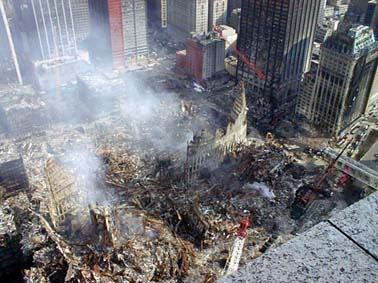
http://www.noaanews.noaa.gov/stories/s798b.htm
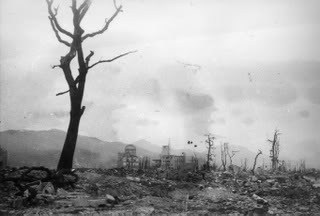
Hiroshima
http://www.pcf.city.hiroshima.jp/virtual/VirtualMuseum_e/exhibit_e/exh0607_e/exh060701_e.html

Streetcar completely gutted by fire. Approx. 320m from the hypocenter
http://www.pcf.city.hiroshima.jp/virtual/VirtualMuseum_e/exhibit_e/exh0603_e/exh060307.html
Vehicles
Charred streetcar

When the atomic bomb exploded, seventy streetcars were operating in Hiroshima. Near the hypocenter, several were burned black. Occupants died where they sat.
http://www.pcf.city.hiroshima.jp/virtual/VirtualMuseum_e/visit_e/est_e/panel/A3/3202_1.htm
Hiroshima – near the hypocenter


Remains of a streetcar (model 100) Approx. 360m from the hypocenter, Togiya-cho (now, Kamiya-cho 1-chome). The model 100 was a wooden streetcar debuted on November 23, 1912, by Hiroshima Electric Railroad, predecessor to Hiroshima Electric Railway Company. Struck on the track as it headed out of town, it was completely burned.
http://www.pcf.city.hiroshima.jp/virtual/VirtualMuseum_e/exhibit_e/exh0603_e/exh060309.html

Car turned into a pile of scrap Approx. 320m from the hypocenter, Shioya-cho (now, Ote-machi 2-chome). The license plate on this automobile left along the tracks in Shioya-cho says “Hiro 172.”
Burnt car near the WTC 7

http://drjudywood.com/articles/dirt/wtc7.html
http://www.pcf.city.hiroshima.jp/virtual/VirtualMuseum_e/exhibit_e/exh0603_e/exh060309.html

http://drjudywood.com/articles/dirt/dirt4.html

http://drjudywood.com/articles/dirt/dirt4.html

http://drjudywood.com/articles/dirt/dirt4.html

http://drjudywood.com/articles/dirt/dirt4.html
Melted vehicles at Ground Zero
VIDEO: Melted cars Dailymotion
Transcript of interview:
Diane Sawyer: And also J.D. Hoffman who’s just a volunterr, came in from Claiformia, and was around the area. I wanted to know how much fire is there, you said you were just at Ground Zero. How much fire’s left?
Volunteer: Well, the Building 7, there was no fire there whatsoever but there was one truck putting water on the building but it’s collapsed completely and then the other building that there were some flames still coming up was World Trade Center One, but not a lot.
Sawyer: You said you saw some melted tour buses, melted cars?
Volunteer: The cars that were right down there – it was just unbelievable. They were twisted and melted into nothing. The buil – the debris is just unbelievable, and then you can see fire trucks and police vehicles that were down there early – that all their windows – their windshields were completely blown out from – must have been when debris dropped.
Melted vehicles and their locations



























http://www.nukefix.org/weapon.html










http://drjudywood.com/articles/DEW/moretoastedcars.html



http://drjudywood.com/articles/DEW/moretoastedcars.html

http://drjudywood.com/articles/DEW/StarWarsBeam5.html

http://drjudywood.com/articles/DEW/StarWarsBeam5.html

http://drjudywood.com/articles/DEW/StarWarsBeam5.html

Burned-out dust-covered cars
http://web.knoxnews.com/web/kns/news/breaking/wtc/438.html

http://drjudywood.com/articles/DEW/StarWarsBeam5.html

http://drjudywood.com/articles/DEW/StarWarsBeam5.html

http://drjudywood.com/articles/DEW/StarWarsBeam5.html

http://drjudywood.com/articles/DEW/StarWarsBeam5.html
Like the department store below, the fire truck is burned inside but relatively unaffected on the outside.

Fukuya Department Store Approx. 710m from the hypocenter, Ebisu-cho
At the time of the bombing, the powerful blast blew furniture, equipment and other items around the building, killing many people. During the subsequent fire, the interior was completely burned, leaving only the shell. After the bombing, the shell became an emergency relief station. After August 17, it was used for a month as a temporary infectious disease hospital. The acute effects of radiation caused bloody stools, leading to a large number of victims being diagnosed with dysentery.
http://www.pcf.city.hiroshima.jp/virtual/VirtualMuseum_e/exhibit_e/exh0603_e/exh060309.html

Notice the flipped car.
http://drjudywood.com/articles/DEW/StarWarsBeam5.html

http://drjudywood.com/articles/DEW/StarWarsBeam5.html

http://drjudywood.com/articles/DEW/StarWarsBeam5.html

http://drjudywood.com/articles/DEW/StarWarsBeam5.html
Vehicles in atomic tests – movie
VIDEO: Vehicles Dailymotion

http://drjudywood.com/articles/dirt/dirt4.html

http://drjudywood.com/articles/dirt/dirt4.html

Road imprinted with the shadow of the bridge railing Around November 1945.
The heat ray scorched and blackened the asphalt, but it remained white where the bridge railing blocked the rays. Picture from: http://glasstone.blogspot.com/
URL: http://www.pcf.city.hiroshima.jp/kids/KPSH_E/hiroshima_e/sadako_e/subcontents_e/08higai_2_e.html

http://drjudywood.com/articles/dirt/dirt4.html

Red-hot, semi-molten metal pulled from the base of WTC building 7 in late October, 6 full weeks after it collapsed, (no plane collided with it, and it was still standing unscathed hours after the twin towers had already collapsed). ArsenalOfHypocrisy
IMG: http://drjudywood.com/articles/dirt/dirt4.html

http://drjudywood.com/articles/dirt/dirt2.html

http://drjudywood.com/articles/dirt/dirt2.html

IMG: yellow-brown fused-silicate sand from the Nevada Sugar ground burst, 1951
In this and each of the following photographs, the photograph on the left hand side is a picture of a 30 micron thick slice through the particle (produced by gluing the particle into plastic resin and then shaving off a thin slice). The image on the right hand side is an radioautograph, i.e., an x-ray like photo in which the source of the image is the action of beta particles from the fallout particle striking a light proofed packet of photographic film. The radioautograph shows, therefore, precisely where the fission products are distributed within each fallout particle.
http://glasstone.blogspot.com/
Thermal Pulse Effects
One of the important differences between a nuclear and conventional weapon is the large proportion of a nuclear explosion’s energy that is released in the form of thermal energy. This energy is emitted from the fireball in two pulses. The first is quite short, and carries only about 1 percent of the energy; the second pulse is more significant and is of longer duration (up to 20 seconds).
The thermal pulse charring the paint

The energy from the thermal pulse can initiate fires in dry, flammable materials, such as dry leaves, grass, old newspaper, thin dark flammable fabrics, etc. The incendiary effect of the thermal pulse is also substantially affected by the later arrival of the blast wave, which usually blows out any flames that have already been kindled. However, smoldering material can reignite later.
The major incendiary effect of nuclear explosions is caused by the blast wave. Collapsed structures are much more vulnerable to fire than intact ones. The blast reduces many structures to piles of kindling, the many gaps opened in roofs and walls act as chimneys, gas lines are broken open, storage tanks for flammable materials are ruptured. The primary ignition sources appear to be flames and pilot lights in heating appliances (furnaces, water heaters, stoves, etc.). Smoldering material from the thermal pulse can be very effective at igniting leaking gas.
http://www.atomicarchive.com/Effects/effects10.shtml
Effects of the thermal pulse on clothing

Thermal radiation also affects humans both directly – by flash burns on exposed skin – and indirectly – by fires started by the explosion.
http://www.atomicarchive.com/Effects/effects10.shtml
Ignition of fires by thermal radiation exposure

ABOVE: U.S. Army photo showing how a mere leaf of Fatsia japonica attenuated the heat flash enough to prevent scorching to the bitumen on an electric pole near the Meiji Bridge, 1.3 km range, Hiroshima. It didn’t even vaporize the leaf before the pulse ended, let alone did it somehow ignite the wooden pole (most photos claiming to show thermal flash radiation effects in Hiroshima and Nagasaki purely show effects from the fires set off by the blast wave overturning cooking stoves, which developed 30 minutes to 2 hours later).
http://glasstone.blogspot.com/
Shadow Imprinted on an Electric Pole at the Foot of Meiji Bridge

The shadow of a Japanese fatsia exposed to the heat rays was imprinted on a telephone pole near the Meiji Bridge (about 1.3 kilometers south from the hypocenter). New shoots replaced the leaves that were burnt away, so the new outline differs from the shadow. Donated by: US Army Pathology Institute / Chugoku Shimbun
http://www.pcf.city.hiroshima.jp/virtual/VirtualMuseum_e/visit_e/subcon/he113c.html
The House in the Middle
VIDEO: The House in the Middle ArchiveOrg | Dailymotion
‘Atomic tests at the Nevada Proving Grounds (later the Nevada Test Site) show effects on well-kept homes, homes filled with trash and combustibles, and homes painted with reflective white paint. Asserts that cleanliness is an essential part of civil defense preparedness and that it increased survivability. Selected for the 2002 National Film Registry of “artistically, culturally, and socially significant” films.’ ArchiveOrg
Text from Glasstone Blogspot:
‘Physically, wood and also skin are poor heat conductors. The top tenth of a millimetre can reach high surface temperatures briefly if exposed directly to a large thermal energy exposure from the fireball, but that doesn’t mean they conduct heat effectively into the depth of material within the time available. House tiles at ground zero in Japan received around 100 cal/cm^2 or so and this blistered the surface, but only the very surface! You can briefly open and look into a conventional oven without being heated up vaporization point by the 250 C or whatever temperature of the food inside, because you take time to heat up. The heat flash from a nuclear detonation is not microwaves. It is just plain old fashioned infra-red, which gets stopped easily.’ Glasstone
Nevada tests on homes

The house on the left has a dark-coloured, unpainted, badly decayed fence; the house on the right has loads of rubbish (old newspapers, straw, etc.) piled against the fence. The house in the middle is clean and painted white.

Close up of rubbish of the house on the right igniting during radiant exposure of 12 cal./sq. cm.
http://glasstone.blogspot.com/

Close up of 3.5 psi peak overpressure blast hitting the house, blowing flaming rubbish about and ripping off roof covering.
http://glasstone.blogspot.com/

Wooden house is ignited by the resulting external fire within 15 minutes of detonation.
http://glasstone.blogspot.com/

Remains look like Hiroshima.
http://glasstone.blogspot.com/

Glaser PDF

http://drjudywood.com/articles/dirt/dirt4.html

https://apunked.files.wordpress.com/2017/02/5575.jpg
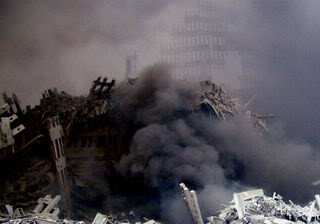
http://www.911research.com/wtc/evidence/photos/groundzero.html

http://www.911research.com/wtc/evidence/photos/groundzero.html

http://www.911research.com/wtc/evidence/photos/groundzero.html
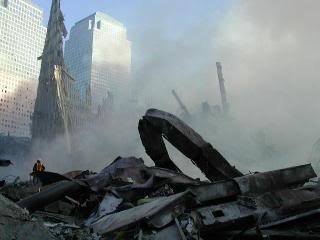
http://www.911research.com/wtc/evidence/photos/groundzero.html

http://www.911research.com/wtc/evidence/photos/groundzero.html

http://www.911research.com/wtc/evidence/photos/groundzero.html

http://www.noaanews.noaa.gov/stories/s798b.htm

http://www.richard-seaman.com/Travel/Japan/Hiroshima/AtomicBombMuseum/IndividualArtifacts/index.html

http://www.richard-seaman.com/Travel/Japan/Hiroshima/AtomicBombMuseum/IndividualArtifacts/index.html
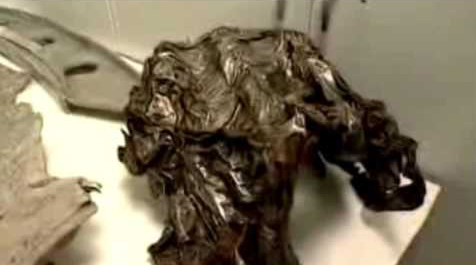
The only filing cabinet found at Ground Zero WTC
http://thewebfairy.com/911/h-effect/filingcabinet.htm
Hiroshima before the bombing:

http://www.richard-seaman.com/Travel/Japan/Hiroshima/AtomicBombMuseum/DamageToCity/index.html
Hiroshima after the bombing:

http://www.richard-seaman.com/Travel/Japan/Hiroshima/AtomicBombMuseum/DamageToCity/index.html
Thermal pulse video 1
VIDEO: Thermal pulse Dailymotion
The energy from the thermal pulse can initiate fires in dry, flammable, materials, such as; dry leaves, grass, old newspaper, thin dark flammable fabrics, etc. The incendiary effect of the thermal pulse is also substantially affected by the later arrival of the blast wave, which usually blows out any flames that have already been kindled. AtomicArchive.com
Thermal pulse video 2
VIDEO: Thermalpulse2 Dailymotion
The energy from the thermal pulse can initiate fires in dry, flammable, materials, such as; dry leaves, grass, old newspaper, thin dark flammable fabrics, etc. The incendiary effect of the thermal pulse is also substantially affected by the later arrival of the blast wave, which usually blows out any flames that have already been kindled. Atomicarchive
Super-Hot Fires
The heat ray generated simultaneously with the explosion of the atomic bomb caused houses, etc., in the hypocenter vicinity to ignite spontaneously. Kitchen flames in houses collapsed by the blast spread and began to consume houses here and there. Such fires rapidly enveloped Hiroshima City in a day-long conflagration that peaked from around 10:00 a.m. to 2:00 or 3:00 p.m. Areas within a two-kilometer radius of the hypocenter were reduced to rubble. Many people trapped under houses collapsed by the blaze were burned alive.
The Damaged Area (Hiroshima)

The areas totally collapsed and burned, totally collapsed, half collapsed and burned, and irreparably damaged spread in nearly concentric circles around the hypocenter. Within a radius of about two kilometers, the city had become scorched earth. The burnt ruins were so covered with materials melted by the extreme heat, the city appeared to have been buried in molten lava. GIF | pcf.city.hiroshima.jp
Damage from the Heat Ray
The temperature at the center of the fireball generated by the atomic bomb at the moment of detonation was more than 1 million degrees Celcius. One second later, the fireball had grown to its maximum diameter of 280 meters. The fierce heat ray emitted from that fireball raised surface temperatures at the hypocenter to 3,000°C to 4000°C. (The surface temperature of the sun is 5,700°C; iron melts at 1500°C.) HiroshimaPeaceSite
Damaged buildings

Eighty-five percent of Hiroshima’s buildings were within three kilometers of where the atomic bomb exploded over the heart of the city. The damage extended to virtually the entire city, with 90 percent of all buildings burned or destroyed beyond repair. HiroshimaPeaceSite
Steel frame twisted by the extreme heat

Steel roof frame of the Yaguranoshita Substation of Hiroshima Electric Railway Company. 280m from the hypocenter. HiroshimaPeaceSite
The Fury of Conflagration : Steel frame twisted by the extreme heat

Odamasa Store. 840m from the hypocenter. Photo by Masami Ogi.
URL: http://www.pcf.city.hiroshima.jp/virtual/cgi-bin/museum.cgi?no=3011&l=e
Materials found melted and fused in Hiroshima
Deformed soft drink bottle
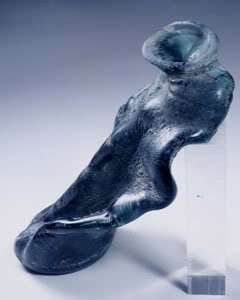
URL: http://www.pcf.city.hiroshima.jp/virtual/cgi-bin/museum.cgi?no=3018&l=e
Roof Tiles
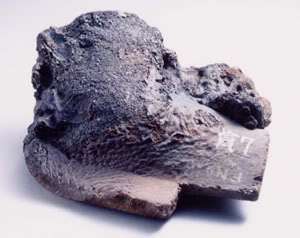
The heat of the fire partially melted these tiles and fused them like a lump of lava. Tiles melt at 1,200 to 1,300{C, which tells us how extremely hot the fire was.
URL: http://www.pcf.city.hiroshima.jp/virtual/cgi-bin/museum.cgi?no=3020&l=e
Fused Lump of Small Glass Bottles

This lump of small glass bottles was dug up from the ruins of an ink factory in front of [Minoru’s] house. The bottles were fused into a lump by the fire. When he saw it, Minoru mumbled, “Must have been really hot.”
URL: http://www.pcf.city.hiroshima.jp/virtual/cgi-bin/museum.cgi?no=3027&l=e
Melted lunch box and ivory pipe

Donated by Tsuneyo Okahara
300m from the hypocenter
Tenjin-machi
Masataro Okahara (then, 49) was exposed to the A-bomb in his office. His wife Tsuneyo immediately tried to get into the city to find him but was stopped by the ferocious flames. On the 9th, she began searching all the relief stations in the city. One week after the bombing, she dug into the ruins of Masataro’s workplace where his desk had been and found bones in the position of a person sitting in a chair. The lunch box and pipe lay at the end of the outstretched right arm. Stunned by this confirmation of her husband’s death, Tsuneyo sank to the ground.
URL: http://www.pcf.city.hiroshima.jp/virtual/cgi-bin/museum.cgi?no=3029&l=e
Roof tiles

These roof tiles were partially melted by the intense heat. The melting point of roof tiles is 1,200 to 1,300℃. Thus, these tiles are evidence of an abnormally hot fire.
URL: http://www.pcf.city.hiroshima.jp/virtual/cgi-bin/museum.cgi?no=3030&l=e
Fused lump of pottery and roof tiles
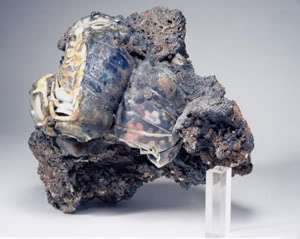
URL: http://www.pcf.city.hiroshima.jp/virtual/cgi-bin/museum.cgi?no=3032&l=e
Fused Lump Containing Human Bones

These were exposed to the super-high-temperature fires.
URL: http://www.pcf.city.hiroshima.jp/virtual/cgi-bin/museum.cgi?no=3033&l=e
Fused lump of metal debris

Donated by Shuichi Morikawa
This is a lump of electric wiring materials melted and fused by the high-temperature fire.
URL: http://www.pcf.city.hiroshima.jp/virtual/cgi-bin/museum.cgi?no=3053&l=e
Fused lump of plates and glass

URL: http://www.pcf.city.hiroshima.jp/virtual/cgi-bin/museum.cgi?no=3069&l=e
Deformed fan

URL: http://www.pcf.city.hiroshima.jp/virtual/cgi-bin/museum.cgi?no=3075&l=e
Human shadow etched in stone

Donated by Sumitomo Bank, Hiroshima Branch
260m from the hypocenter
A person sitting on the bank steps waiting for it to open was exposed to the flash from the atomic bomb explosion. Receiving the rays directly from the front, the victim undoubtedly died on the spot from massive burns. The surface of the surrounding stone steps was turned whitish by the intense heat rays. The place where the person was sitting remained dark like a shadow. HiroshimaPeaceSite
Carbonized Kaoliang (sorghum beans)

Donated by Masao Michida
1,600m from the hypocenter
Funairisaiwai-cho
This kaoliang was stored for emergencies in an air-raid shelter in a lumber factory belonging to the donor Masao Michita (then, 43). It was completely carbonized by the super-high-temperature fire. Masao stayed the previous night at the Hiroshima District Lumber Control Corporation where he worked the nightshift on the second floor of the Hiroshima Prefectural Industrial Promotion Hall. He finished work at 8:05 a.m. and was exposed to the bomb immediately after returning home and was trapped under his house. His wife Yoshie (then, 30) was in the kitchen with a glass fragment stuck in her head. Their sixth son Mikio (then, 6) was burned on his back by the heat ray; his shirt and hair had burst into flame. He died later that night. The doors of the bomb shelter where they kept their precious store of food saved for emergencies were extremely strong and heavy. Nevertheless, they were blown away by the blast and set on fire. They smoldered for nearly a month. <—- SPECIAL NOTE [Sound familiar? Fires at the WTC burning for 3 months.] HiroshimaPeaceSite
Hot spots

Click to open larger 315 KB image
AVIRIS image from September 16, 2001. Hot spots show as orange and yellow areas. Yellow is hotter than red (because of color mixing in the way the 3-color image was produced).
http://pubs.usgs.gov/of/2001/ofr-01-0429/thermal.r09.html
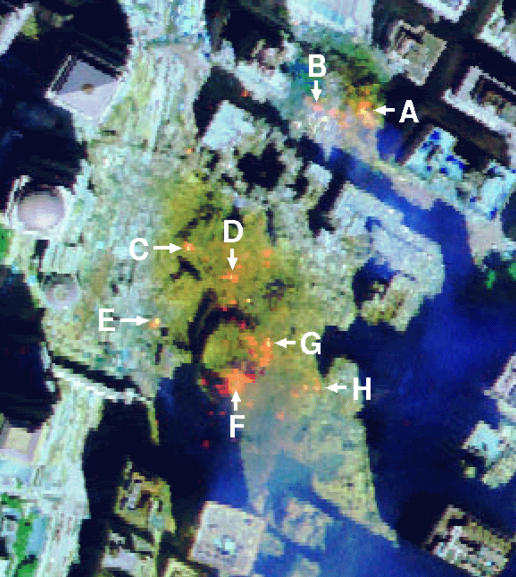
http://pubs.usgs.gov/of/2001/ofr-01-0429/thermal.r09.html
Index for the locations of some of the hot spots observed on September 16, 2001.
Initial analysis of these data revealed a number of thermal hot spots on September 16 in the region where the buildings collapsed 5 days earlier. Analysis of the data indicates temperatures greater than 800oF. Over 3 dozen hot spots appear in the core zone.


Table of temperatures using data from the map above
| Location | Fahrenheit | Celsius | Name |
| A | 1341 | 727 | WTC7 |
| B | 1034 | 557 | WTC7 |
| C | 1161 | 627 | WTC1 |
| D | 963 | 517 | WTC1 |
| E | 819 | 437 | WTC3 |
| F | 801 | 427 | WTC2 |
| G | 1377 | 747 | WTC2 |
| H | 1017 | 547 | WTC4 |
http://www.arsenalofhypocrisy.com/911/9-11_Truth.htm

http://www.arsenalofhypocrisy.com/911/9-11_Truth.htm

Geometrically rectified image of the WTC core region showing hot spot locations.
http://pubs.usgs.gov/of/2001/ofr-01-0429/thermal.r09.html
________________________________________________________________
WTC House of God – molten red hot metal being picked up by forklift

Three weeks after the collapse, temperatures inside the rubble pile were still hot enough for steel to be glowing red-hot. 9eleven.info/SmokingGuns
_______________________________________________________________
Twisted Steel

[T]he team sought items to represent the hellish forces unleashed that day. “We saw a lot of pieces like this,” said Wagner. “Typically, when steel bends, it buckles and tears. The smooth bend on this piece shows the steel became malleable — a pretty good indication of how hot it was.”
http://www.pbs.org/americarebuilds/artifacts/artifacts_09.html

More Bent Steel
“This piece has a ribbon-like quality to it,” noted Wagner. “It’s like it just crumpled when it hit the ground.” Engineers have noted that many of the Towers’ girders were contorted into shapes unreplicable by any machine.
http://www.pbs.org/americarebuilds/artifacts/artifacts_10.html

Burned Car
Thousands of cars were removed from Ground Zero — some burned beyond recognition, others only lightly damaged. Most cars were taken by barge to Staten Island’s Fresh Kills dump where their parts were either salvaged for recycling, or buried. “The rubber had melted away from thousands of tires,” said Wagner. “You just saw the steel belts wrapped around the rims.”
http://www.pbs.org/americarebuilds/artifacts/artifacts_11.html

b. The thermal radiation emitted from the fireball surface during the second thermal pulse is responsible for most of the thermal effects. It consists chiefly of radiation in the infrared, visible, and ultraviolet regions of the electromagnetic spectrum. Thermal exposure (measured in joules per unit area of exposed surface) will be less farther from the center of the explosion because the radiation is spread over a greater area and is attenuated in passing through the intervening air. Since the fireball is very close to a point source of thermal radiation, the quantity of thermal radiation at any given point varies approximately with the square of the distance from the explosion. The inverse square law does not apply exactly because thermal radiation, particularly ultraviolet, will also be absorbed and scattered by the atmosphere. The degree of atmospheric visibility affects the attenuation of thermal energy with distance to a limited degree, but less than would be expected from the purely absorptive properties of the atmosphere, because the decrease in transmission is largely compensated by an increase in scattered radiation.
http://www.fas.org/nuke/guide/usa/doctrine/dod/fm8-9/1ch3.htm
Nevada nuclear tests on houses and dummies
VIDEO: Nuclear Tests on Houses and Dummies at Nevada Test Site – Operation Cue (1955) Dailymotion
Tattoo of dress print (7:44 minute mark). Tattooing of print from a dress, similar to what happened in Japan – woman’s kimono imprinted on woman’s skin.

Hiroshima victim of bombing – dress pattern is tattoed onto skin
Instant pulverization of telephone wires

10:49 minutes in Dummy Town video

10:49 minutes in Dummy Town video
Dummy Town
VIDEO: Dummy Town Dailymotion | Youtube
Transmission tower on top of the North Tower aspirating
VIDEO: North Tower steel core ablating into dust Dailymotion
You can see the transmission tower aspirating. This video also shows the nuclear glow. Notice the sudden brightening of the screen as the North Tower explodes.

The spire is in the background. A water tank is in the foreground on top of another building.

Adapted from: http://drjudywood.com/articles/why/why_indeed.html

The base of the massive transmission tower. The spires of the transmission tower are ablated in the gif above. URL:
http://www.amny.com/community/news/manhattan/am-wtcrelics-pg2006,0,2565436.photogallery?coll=amny_community_news_manhattan_util

http://drjudywood.com/articles/dirt/dirt2.html

http://www.bcrevolution.ca/scientific_facts.htm

“Survival Town”
VIDEO: Survival Town. Dailymotion
Atomic bomb blasts a fake town.
3:00 minutes in Survival Town video
“House in the Middle”
VIDEO: House in the Middle Dailymotion
THERMAL
Those closest to the explosion died instantly, their bodies turned to black char. Nearby birds burst into flames in mid-air, and dry, combustible materials such as paper instantly ignited as far away as 6,400 feet from ground zero. The white light acted as a giant flashbulb, burning the dark patterns of clothing onto skin (right) and the shadows of bodies onto walls. Survivors outdoors close to the blast generally describe a literally blinding light combined with a sudden and overwhelming wave of heat. [Hiroshima]
http://www.mbe.doe.gov/me70/manhattan/hiroshima.htm
After finishing his shift at the factory, Akio Sakita returned home and went to his backyard to do the washing. He heard the drone of airplanes above, but since the air raid alarm had been called off, he assumed that the planes he saw were Japanese planes out on surveillance runs. At that moment, he heard a loud roar in the sky, and as he looked up, “wondering if it had in fact been the enemy, a blinding flash of light filled the sky and my body was showered in a wave of intense heat. I felt a searing pain in my face and threw myself on to the ground with my eyes firmly shut. The rush of heat continued for several seconds. It was like a glimpse into the horror of hell. . . . I had suffered terrible burns all over the upper half of my body. [Hiroshima]
http://users.dickinson.edu/~history/product/steele/seniorthesis.htm
Mr. Sumiteru Taniguchi was a sixteen year old postal carrier at the time of the bomb. He was delivering mail on his normal route in Sumiyoshi town when the atomic bomb exploded. “After the sky flashed as lightning I was thrown with a bicycle on the ground when I came to around my skin on the left arm peeled off and hung down to fingertip, my back and hips were burned and became sore and clothes nearly didn’t remain. [Nagasaki]
http://users.dickinson.edu/~history/product/steele/seniorthesis.htm
Around the Matsuyama-cho intersection which is close to the hypocenter, victims were burned to death in their last gesture grasping at the air or trying to escape. Everything that burns was burnt. Roof tiles were crushed into small pieces and scattered all over, air-raid shelters and street cars were burned and ruined. All tell the miserable story without words. [Nagasaki]
http://www.gensuikin.org/english/photo.html
Eiko Taoka, then 21, was one of nearly 100 passengers said to have been on board a streetcar that had left Hiroshima Station at a little after 8:00 a.m. and was in a Hatchobori area, 750 m from ground zero, when the bomb fell. Taoka was heading for Funairi with her one year old son to secure wagon in preparation for her move out of the building which was to be evacuated. At 8:15, as the streetcar approached Hatchobori Station, an intense flash and blast engulfed the car, instantly setting it on fire. Taoka’s son died of radiation sickness on August 28. The survival of only ten people on the streetcar have been confirmed to date.
When we were near in Hatchobori and since I had been holding my son in my arms, the young woman in front of me said, I will be getting off here. Please take this seat.’ We were just changing places when there was a strange smell and sound. It suddenly became dark and before I knew it, I had jumped outside…. I held [my son] firmly and looked down on him. He had been standing by the window and I think fragments of glass had pierced his head. His face was a mess because of the blood flowing from his head.Eiko Taoka, then 21, was one of nearly 100 passengers said to have been on board a streetcar that had left Hiroshima Station at a little after 8:00 a.m. and was in a Hatchobori area, 750 m from ground zero, when the bomb fell. Taoka was heading for Funairi with her one year old son to secure wagon in preparation for her move out of the building which was to be evacuated. At 8:15, as the streetcar approached Hatchobori Station, an intense flash and blast engulfed the car, instantly setting it on fire. Taoka’s son died of radiation sickness on August 28. The survival of only ten people on the streetcar have been confirmed to date.
http://www.atomicarchive.com/History/twocities/hiroshima/page14.shtml
The Darkness Immediately after the Explosion — Why did it get pitch-dark?
Tsutomu IGARASHI
In Chiyoko KUWABARA’s testimony, she mentioned that “it got pitch-dark” right after the explosion. In others’ atomic-bomb testimonies on record, we often find descriptions of “a shroud of darkness”. What’s the cause of it? I would like to infer the cause based on “Genshibakudan Saigai Chousa Houkokushu (Collection of Investigation Reports on Atomic Bomb Disaster)”published by the Japan Society for the Promotion of Science, 1953.
Could only dust cause that darkness? What caused the light to be completely blocked for as long a few dozen minutes? I think this can relate how tremendous the atomic-bombing was. Considering that not only the people indoors but the people outdoors like Chiyoko KUWABARA were also shrouded in darkness, it seems that some more complicated and fierce mechanism was hidden in this phenomenon of darkness.
At the point of atomic-bomb explosion above ground zero, “the temperature rose up to the extreme heat of a few million degrees Celsius and a fireball of several hundred thousand atmospheric pressures was created”, the Report says. It continues that “following that explosion the bomb blast (a shock wave and the blast wind), heat rays (infrared rays and visible rays) and initial radiation (gamma ray and neutron) were emitted.” (all information is by courtesy of Kunio NAGATA, teacher at Hiroshima Municipal Ujina Junior High School)
What happened at first was that, by the creation of a fireball, heat rays were emitted and everything was incinerated in a split second. Even on the ground in the hypocenter vicinity, temperatures reached several thousand degrees Celsius. Melted roof tiles and glass can verify that. Heat rays burned out everything. But it only lasted a moment. It says “The fireball blazed for ten seconds”, but I presume in fact it blazed for a second or two and lost its intense heat rapidly. So we can suppose that everything was ignited at that moment due to the heat of several thousand degrees Celsius.
Every organism exposed directly to the heat rays was burned. Trees, grass, houses, and walls, anything burnable was charred when they were exposed to the heat rays and their surfaces also became rough and were bubbled by the intense heat.
There are two things we tend to overlook: First are particles in the air. Numerous fine particles like dust and specks are suspended in the air. Those particles would be charred in a moment.
Related to this, U. S. bombers like the Enola Gay were strictly prohibited to bomb with radar; bombing by sight was always required. After studying the long term records of weather, they intentionally chose a fine clear day. The U.S. Forces really emphasized bombing by sight.
This was because bombing by sight was more accurate. But a more important reason was, if there were clouds, heat rays and radiation would be blocked by the particles in the clouds, and the effects halved. Absorbing the heat rays and the blast, clouds reduce the effects of bombing. If it is raining on the ground, the effects are much more reduced, not only by the particles in clouds but also by the water drops from them. Observation of the explosion also can be disturbed.
That was why they desperately needed a fine clear day for the world’s first atomic bombing. In other words, they chose a clear day not for bombing by sight but more to maximize the effects. As a result, bombing by sight required fine weather to target accurately, and bombing with radar was banned for that purpose.
I guess the U.S. already knew about the phenomenon of particles in the air burning and had its data. Charred particles were one of the factors causing the darkness we can’t overlook.
What also burned was the skin of animals and people’s clothes, as Kunio NAGATA, teacher at Hiroshima Municipal Ujina junior high school, mentioned.
When hibakusha were badly damaged by the atomic bombing, they were almost naked. Where were their clothes? At the first stage of the explosion the clothes exposed to the heat got charred and tattered instantaneously. And the heat rays penetrated the clothes, more heat absorbed at the dark parts of clothes, and then burned the skin. The skin also got burned and was hanging like rags. Naturally some parts of their hair got burned, too.
At the second stage, the blast came with the velocity of several hundred meters per second, sweeping away those charred organic materials. So what was left were people whose clothes and burnt skin had been swept away. People were naked or had their flesh exposed without skin. At the same time dirt and burned objects rushed back to them, made their faces filthy, terribly distorting their appearances. The blast wind would carry away some parts of the tissue-damaged skin. There were many people with the remnants of their torn skin hanging from their bodies.
We can see the fierceness of the shock wave from the Atomic-bomb Dome which was almost directly under the explosion. With that super high pressure hitting the ground it is not hard to imagine that the shock wave scooped out the soil and produced tremendous dust. Dust, houses, debris, concrete, and broken roof tiles were all swirled up and then blown away outwards.
And the shock wave hit not only once but twice. First the shock wave generated by the explosion traveled outward with a force several hundred thousand times normal atmospheric pressure. Then, because of the extremely low pressure at the center area, it became a vacuum; and then air rushed back in from the area around it with tremendous speed. That means people were stripped naked by the two blast winds in a few seconds.
The air that rushed in contained all sorts of burnt objects you can think of, including soot, dirt, dust, and the wreckage of buildings, blowing back towards the point of detonation 580 meters above the ground. Inorganic matter didn’t change color much but organic matter got charred and rushed back in. Trees, grass, particles in the air, skins of creatures, clothes, charred human skin and hair, all were absorbed and concentrated. Those which heated to a higher temperature went up further from the central point, forming a huge umbrella which was the lower part of the mushroom cloud. The reason that the lower part of the cloud was dark was that it contained incinerated objects. It was not just due to dirt or debris. We should assume that only incinerated objects which have lighter mass could go that high up.
Those objects went up to the sky and immediately formed a kind of a dome. Directly below it objects had already ignited and were flaming up. With this heat some parts kept rising up forming cumulonimbus cloud. The dome with a 1 kilometer- radius containing these incinerated substances was formed in the sky over ground zero, light was blocked and the ground was shrouded in darkness. This was what happened in just dozens of seconds.
The top of mushroom cloud reached about 9000meters high 8 minutes after the explosion.
Just then the wind was blowing from south-east. The rising cumulonimbus cloud drifted to the north-west as time went by, then was exposed to cold air and became rain that fell on the ground. This is “black rain”. The black rain contained charred organisms, namely burned human skins, hair and burned up clothes. This black rain also contained a great deal of radioactive substances.
The dozens of minutes of darkness generated by the atomic bombing symbolizes the tremendous power and its realities of it. It can be said that the fact that people were stripped naked in a split second led to this dome of darkness. We can also say the dome contained very small amount of burnt skin and clothes and blocked light.
Try to imagine the awful destructive power.
http://homepage2.nifty.com/hiroshimaaozora/yamiEnglish.htm
Interview with Patricia Ondrovic
KT: What did you do when the South Tower started coming down?
PO: I didn’t know what was happening, but there was a loud “roar” — lots of crashing sounds. I was attempting to put my stretcher back into the vehicle. The ground was shaking and I saw a sea of people, mostly the various agencies on scene, Fire, Police, EMS, all running towards me. I had no idea what they were running from, but I decided I’d be ahead of them and just started running west towards the river. As I was running, parked cars were blowing up and some were on fire, the street was cracking a bit as well. Very shortly after I started running, everything became one big black cloud. I was near the West Side Highway and I couldn’t see around me anymore.
http://killtown.blogspot.com/2006/02/911-rescuer-saw-explosions-inside-wtc.html
Patricia Ondrovic interview
KT: You talked about the cars blowing up in your WTC Task Force interview, correct?
PO: Yes.
KT: Can you estimate how many vehicles blew up around you?
PO: At least three and some were on fire as I was running by. I was still on the south side of Vesey running west. The burning cars were between my ambulance and about the middle of the 6 World Trade where the lobby doors were at.
http://killtown.blogspot.com/2006/02/911-rescuer-saw-explosions-inside-wtc.html
Map

http://drjudywood.com/articles/dirt/dirt4.html
Smoke and heat
VIDEO: Wtc1_stairway_hot Dailymotion
Survivor in WTC 1 stairwell during WTC 2 collapse: “…and all of a sudden this huge cloud of dark grey smoke comes shooting up the stairway … and it was hot – very, very hot.”
___________________________________________________________




